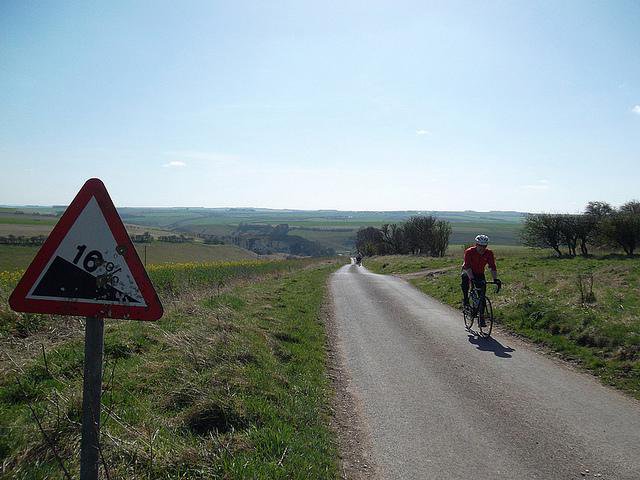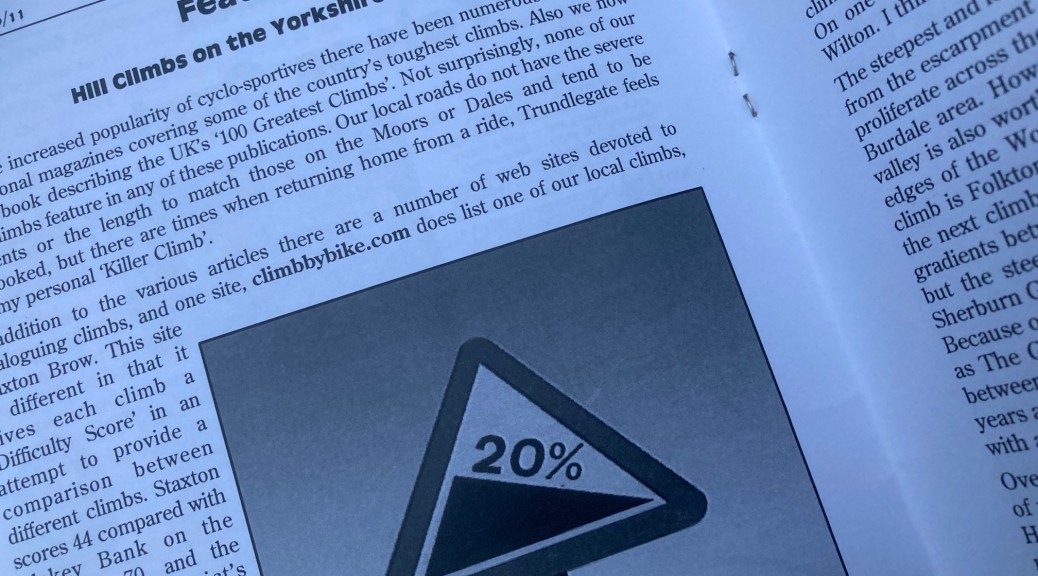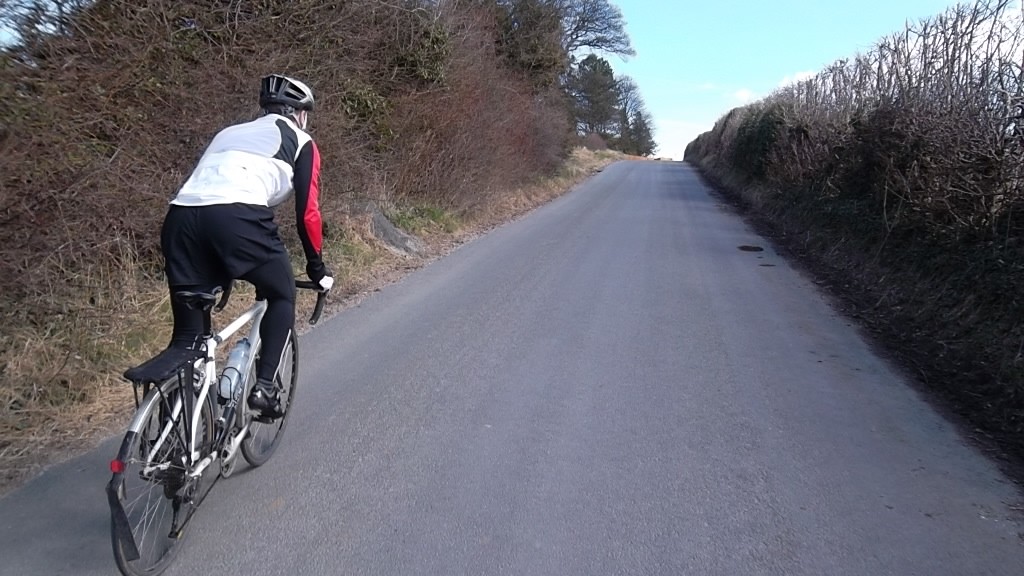With the increased popularity of cyclo-sportives there have been numerous articles in the national magazines covering some of the country’s toughest climbs. Also we now have a book describing the UK’s ’100 Greatest Climbs’. Not surprisingly none of our local climbs feature in any of these publications. Our local roads do not have the severe gradients or the length to match those on the Moors or Dales and tend to be overlooked, but there are times when returning home from a ride Trundlegate feels like my personal ‘Killer Climb’.

Burdale: a short, sharp climb but is it long enough to be amongst the toughest climbs on the Wolds?
In addition to the various articles there are a number of web sites devoted to cataloguing climbs, and one site, climbbybike.com does list one of our local climbs, Staxton Brow. This site is different in that it gives each climb a ‘Difficulty Score’ in an attempt to provide a comparison between different climbs. Staxton scores 44 compared with Blakey Bank on the Moors at 70, and the Lake District’s Hardknott Pass (West) which tops the English climbs with a score of 106. These scores show why climbs on the Wolds do not figure in national surveys. Nevertheless some of the climbs can offer tough challenges to a tired rider.
The Ordnance Survey map only shows three roads on the Wolds with a double chevron: Flixton, Staxton and Acklam, indicating a gradient of 1 in 5 or steeper. Both Flixton and Acklam have road signs confirming a 20% gradient, but the sign at the top of Staxton only shows 17%. In addition to these climbs there are numerous roads with a single chevron indicating a gradient between 1 in 7 and 1 in 5. Could some of these longer climbs be harder than the short but steep roads up Flixton or Acklam?
With digital Ordnance Survey maps it is now relatively easy to get an accurate profile of a hill to arrive at an average gradient and calculate a Difficulty Score.
However, it is one thing to sit at a computer and decide which is the hardest climb based on data from a map, the real test is to get out there and ride the climb. I also wanted to check the actual gradient since many of the minor roads lack a gradient sign and a single chevron on the map covers a range of 13% to 20%. One way to measure the gradient is to use an inclinometer. Searching the web I found a German model specifically designed for cyclists. This is a simple graduated spirit level that clamps to the handlebars and gives a reasonably accurate measure of the gradient. I tried the inclinometer on different bikes and decided that my Moulton gave the best reading as the suspension cuts out a lot of vibration to the bars. I also experimented with a cycle computer which calculated the slope by measuring the change in altitude, but this turned out to be very inaccurate, as do the GPS units which work on the same principle. So equipped with the inclinometer I have spent the autumn weekends exploring some of those vertical lanes which many of us go out of our way to avoid at all costs. I rode and checked all the climbs listed except the main road climbs of Staxton, North Grimston and Garrowby. On one afternoon I climbed 5 of the big climbs between Leavening and Bishop Wilton. I think my knees were trying to tell me something that evening!
The steepest and longest climbs lie on the northern and western escarpments, but away from the escarpment there are many shorter roads climbing out of the dry valleys that proliferate across the Wolds, with many of the best climbs lying in the Thixendale and Burdale area. However further east the isolated hamlet of Fordon nestling deep in a valley is also worth a visit, but here I have concentrated on the northern and western edges of the Wolds. Starting in the north eastern corner of the Wolds the first real climb is Folkton Brow (16%) which I found quite busy and unappealing. Moving west the next climb is Flixton Wold which is a real killer sporting a 300 metre ramp with gradients between 16% and 20%. This road is probably marginally steeper than Acklam but the steep section is not as long. Next come Staxton Brow, Ganton Wold and Sherburn Grits.
These are all 17% climbs in spite of the 16% sign at the top of The Grits. Because of their location adjoining the A64 we tend to avoid these roads which is a pity as The Grits is a super climb up a narrow lane with a leg sapping middle section of between 12% and 17% for nearly 700 metres. I last climbed this hill as a teenager over 50 years ago when it had a fearsome reputation. I then climbed it on a 5 speed Holdsworth with a 49 inch bottom gear, now I need something nearer a 29 inch gear.
Over the next section towards Birdsall the escarpment is more broken with a number of valleys cutting back into the Wolds, and the climbs become easier. However, West Heslerton which has been used on the Milk Race, is another tough climb. Don’t be misled by the 16% sign at the bottom – the middle section is consistently steep with gradients between 12% and 17% for 400 metres.
Despite the 17% sign at the foot of Settrington it is not that hard with a predominant gradient between 10 and 13% and only two short steep ramps of 16% and 17%. Birdsall marks the north western corner of the Wolds as the escarpment heads south to the Humber, and the next section between Leavening and Bishop Wilton offers eight roads climbing up to the highest section of the Wolds. These range from the brutal Acklam Wold which attacks the escarpment head on, to the scenic climb out of Bishop Wilton which winds its way up an attractive wooded valley. Most local cyclists will have climbed Leavening Brow but how many of us are familiar with Uncleby or Worsen Dale?
Although only a short climb, Acklam Wold has a well-deserved reputation for being a killer climb on a par with Flixton. Leaving the village the road rapidly steepens to between 15% and 20% for 500 metres as it climbs straight up the hillside to the communication mast at the top of the wold.
Just south of Acklam village is another road heading up to the communication mast. Starting at the junction near Barthorpe Lodge Farm this road has the longest and highest ascent in the area at 3.5 km with 178 metres of height gain. With only one chevron shown on the map and an average gradient of 5% it looks quite easy. However, there are some steep sections of up to 15% on the lower road and a short but steep section of 20% near the top, but there are some level sections where the rider can recover. In spite of its low score this is a great climb. Heading south again the next village is Kirby Underdale. Nestling in the huge amphitheatre of Open Dale there are three roads climbing up the bank through woods and pastures. The first, Hanging Grimston, is not only my own personal favourite but is one of the best climbs on the Wolds. The two single chevrons on the map hide the true statistics of this 1.5 km 153 metre climb with an average gradient of 10% and a maximum of 20%.
Turning off the Kirby Underdale road the narrow lane to Hanging Grimston descends steeply to Salamanca Beck where the climb starts. Immediately the road kicks up at 15% to 20% for 100 metres. Fortunately the momentum gained on the downhill should get the rider up this stretch and onto an easier section where the gradient varies between 5% and 10% as the lane climbs gently though unfenced open pastures. Approaching the farm set back on the right, the climb steepens to 14% before rounding a left hand bend and a gate which may be closed. The rider then approaches the final section of road lined with beech trees, passing the old 1-in-6 road sign for the final 500 metres of 16% before the gradient finally eases. The road surface is quite rough and broken, but not potholed, and by using both sides of the road it is possible to pick a reasonable line. This is a super climb in lovely surroundings.
The next road is another lane through the little hamlet of Uncleby. This is a straight forward and unusual in so much that the gradient is pretty uniform throughout varying between 10% and 15% for a kilometre before easing back approaching the junction at the top. Although the narrow road climbs straight up the escarpment it is an attractive route bordered by mature trees and woodland. When riding this hill I felt it was the easier of the three Kirby Underdale climbs in spite of its high score.
The third climb is the popular Painsthorpe road which ascends from the church and quickly steepens to 17% as it passes the Hall before easing back to 10% approaching the hamlet of Painsthorpe. From here it is an easy 5% to the top of the wold. This route should be familiar to those who have completed the 70-mile version of the George Herbert Stancer standard ride.
Bypassing the main road up Garrowby Hill, which has become a weekend race track for bikers, the next climb of interest to the cyclist is from Bishop Wilton village to Garrowby top. This is a lovely climb up through the mature beech woods of Worsen Dale. Starting in the village, climb gently along the stream past the village church, turn left at the head of the village past the primary school then right onto Worsendale Road and continue climbing, first at 5% gradually steepening to 10%. The road then continues with gradients up to 15% before easing and emerging from the woods at the junction with the main road close to the highest point on the Wolds.
Beyond Bishop Wilton the climbs become easier as more dales cut into the hills. The next climb of any distinction is Nunburnholme which we often climb on our Sunday runs. Fortunately, the steepest section of 14% is at the bottom of the climb, which is then followed by 800 metres of 5% to 10% steady climbing.
South of Market Weighton we are on home territory as the Wolds become lower. Nestling along the southern edge of the Wolds is one of my favourite climbs, Brantingham Dale. The pretty approach up the dale starts easily enough but the gradient steadily steepens to 10% for the final 300 metres, which includes two steeper ramps of 13% and 14%. The council have recently erected a sign at the top showing a gradient of 11% which is very misleading.
Fortunately I managed to complete all but one of the climbs before the bad weather arrived at the end of November. Since then I have been able to review all the data gathered on the climbs to produce the table below. The list includes a Difficulty Score based on the climbbybike.com formula. This was originally developed for ranking long alpine climbs and can produce anomalies with short climbs, particularly on the Wolds where it can be difficult on some climbs to decide where to set the start and finish lines. It is based largely on the length of the climb and average gradient, not the maximum gradient. Also I have only included climbs of 800 metres or more. However, the results do make interesting reading to compare routes.
Notes
* indicate my own maximum gradient readings
** indicate hills where my own reading was higher than the road sign
? Garrowby is the only hill I did not visit
The maximum gradient shown in the table is based on the higher of either my own reading or the road sign. As the signs are based on the old convention of 1 in 6 (17%) and 1 in 5 (20%) we do not see any signs for climbs of 18% or 19%. My inclinometer only had a maximum reading of 20% and it was difficult to get an accurate reading once over 17%, but I am sure that some of the signed 20% hills were less, and in due course I will be back to check out those hills. A nice ride for next spring.
A version of this post originally featured in the Winter 2010/2011 edition of the Woldsman and appears here by kind permission of Roger England.
Simon Warren since wrote a follow-up book, Another 100 Greatest Climbs, which included Hanging Grimston. Seven hill climbs of the Yorkshire Wolds subsequently featured in Warren’s later ‘Cycling Climbs of Yorkshire: A Road Cyclist’s Guide’
It's back! An oldie but a goodie, and from the days when @100climbs was the new kid on the block, Roger England's excellent 'Hill Climbs on the Yorkshire Wolds', used by kind permission. Huge motivation for @sensisuperstar, @CharlieRispin, me & many more:https://t.co/f0adH4pmcU pic.twitter.com/HCVrarewyh
— Cycling the Yorkshire Wolds (@CycleTheWolds) April 2, 2021






It is great to hear that after 10 years my piece for the Woldsman has inspired riders to get out and explore the Wolds. It is a fantastic area for cycling with a network of quiet lanes and climbs. I am now in my late seventies but even after 60 years of exploring the Wolds I am still finding new lanes and climbs. There is a lifetime’s cycling out there just waiting to be discovered.
Your piece is always worth a re-read, Roger.
I cycled up Hanging Grimston recently, with the intention of photographing the old 1:6 sign at the bottom of the last push to add to this blog post. Sadly, it had been replaced with a modern % sign. That was bad enough, but it meant I had no excuse to stop for a breather
Thanks again for letting me reuse your article.
You have missed Givendale Lane which is the next one to the right of Worsendale. That is a challenge and made harder due to having no run-up.
Apologies for the late reply to your comment, but thanks, James. I might try that one next time I get out Pocklington way.